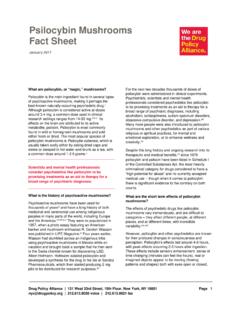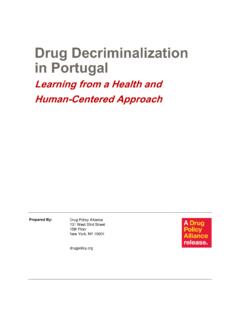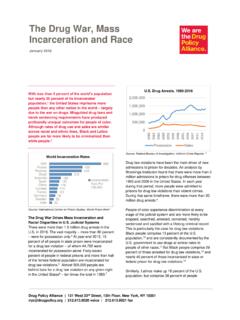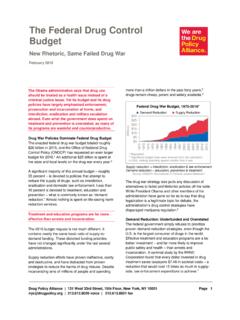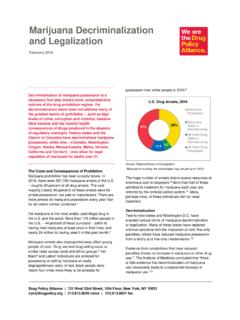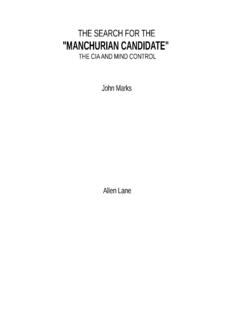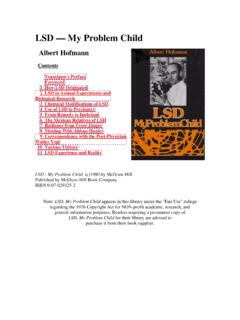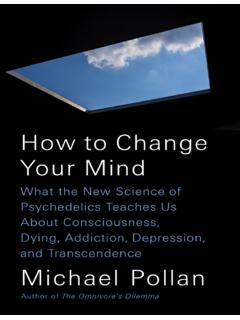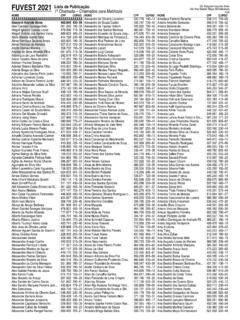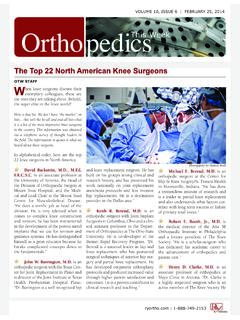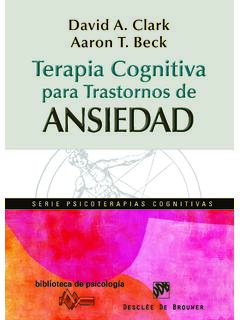Transcription of LSD Fact Sheet - Drug Policy Alliance
1 Drug Policy Alliance | 131 West 33rd Street, 15th Floor, New York, NY 10001 | voice | fax Page 1 LSD Fact Sheet January 2017 What is LSD? Lysergic acid diethylamide, commonly referred to as LSD, or acid, is considered the best known and most researched psychedelic LSD is active at exceptionally small doses (around 20 micrograms) and is taken orally, sometimes as droplets or more commonly on blotter paper and absorbed on the tongue and then swallowed. LSD was discovered in 1938 by albert hofmann , a Swiss chemist working at Sandoz Laboratories, who later became the first person to experience the drug s psychoactive effects after he accidentally ingested a small amount in 1943. The effects hofmann reported included, restlessness, dizziness, a dreamlike state and an extremely stimulated imagination. ii Sandoz sent samples of LSD to psychiatrists, scientists, and mental health professionals around the world for more research.
2 For the next two decades, thousands of experiments with LSD led to a better understanding of how LSD affected consciousness by interacting with the brain s serotonin neurotransmitter Scientists considered psychedelics to be promising treatments as an aid to therapy for a broad range of psychiatric diagnoses, including alcoholism, schizophrenia, autism spectrum disorders, and Thousands of people were also introduced to psychedelics as part of various religious or spiritual practices, for mental and emotional exploration, or to enhance wellness and creativity. Recent results from epidemiological studies have shown lower rates of mental health disorders and suicide among people who have used psychedelics like ,vi,vii LSD is currently in Schedule I of the Controlled Substances Act, the most heavily criminalized category for drugs. Schedule I drugs are considered to have a high potential for abuse and no currently accepted medical use though when it comes to LSD there is significant evidence to the contrary on both counts.
3 What is the cultural history of LSD? In the 1960s, non-medical use of LSD was popularized by poets and musicians, like Allen Ginsberg and The Beatles, and outspoken advocates like Harvard professors Tim Leary and Ram Dass (then Richard Alpert).viii The epicenter of the culture around LSD use, San Francisco, was the home of what became known as the Summer of Love in 1967. In the popular press and among politicians, LSD became associated with this youth-led social movement steeped in antiwar demonstrations, sexual experimentation, and cultural upheaval, which largely ignored some of the potential downfalls of widespread use in uncontrolled LSD s widespread popularity at the time meant that it was often used in chaotic settings and sometimes by people who did not know what they were taking or who were otherwise unprepared for the Media began reporting on strange behavior and negative outcomes associated with LSD use.
4 In 1968 President Nixon declared drugs to be public enemy number one and in 1970 signed the Controlled Substances Act, placing LSD in Schedule I. Nixon s domestic Policy chief admitted decades later that their declaration of a war on drugs was a tool to vilify the anti-war left, Black people, and other minorities: Did we know we were lying about the drugs? Of course we did. xi Scientists consider psychedelics to be promising treatments as an aid to therapy for a broad range of psychiatric diagnoses. 2 Drug Policy Alliance | 131 West 33rd Street, 15th Floor, New York, NY 10001 | voice | fax Page What are the short term effects of LSD? The effects of psychedelic drugs like LSD are difficult to categorize they affect different people, at different places, and at different times, with incredible xiii However, LSD and other psychedelics are known for their profound changes in consciousness and perception.
5 LSD s effects last around 8-10 hours, with peak effects occurring 4-6 hours after ingestion. These effects include sensory enhancement, sense of time changing (minutes can feel like hours), real or imagined objects appear to be moving (flowing patterns and shapes) both with eyes open or closed, unusual thoughts and speech, personal insight and reflection, and excited Individual reactions to these perceptual changes are very much based on set and Set (or mindset ) refers to the psychological state and the beliefs of the person taking the drug. Setting is the external circumstances they re in the people around them and their environmental surroundings. Because set and setting vary so widely from person to person, and even from experience to experience, each LSD experience can produce vastly different outcomes from frightening to deeply meaningful and positive life-changing experiences (though some parts may still be overwhelming or psychologically jarring).
6 Can LSD and other psychedelics be used as medicine or therapy? Yes. Fully legal research programs in the mid-20th century that involved tens of thousands of patients found that carefully monitored and controlled use of LSD may be beneficial for many psychiatric disorders, personal and spiritual development, and creative enhancement for healthy However, after LSD was banned in 1970, clinical research to evaluate its medical safety and efficacy was effectively halted until the late 90s and early Today, there are more than a dozen studies taking place to evaluate the medical safety and efficacy of psychedelics, including Although much of the early LSD research did not stand up to today s standards, as they often lacked a placebo control group or double-blinding procedures (in which neither the subject of the research nor the investigators knew whether the subject received LSD or placebo).
7 Nevertheless, their promising findings have been revisited and spurred a resurgence of new, more rigorous research on the potential benefits of psychedelics as a treatment for cluster headache,xvii anxiety,xviii,xix,xx addiction to alcohol and other drugs,xxi and depression, xxii,xxiii as well as neuroimaging experiments furthering the understanding of its effects on the In a small pilot study in humans, LSD has once again been shown to be a promising medicine for cancer- related anxiety. The lead psychiatrist on that study in Switzerland has tightly regulated approval from the national ministry of health to treat patients in his private practice with LSD, for use in any indication, with his discretion and Because of the expensive and labyrinthian approval process for research with Schedule I drugs, as well as the political influence of the war on drugs, research evaluating LSD s beneficial uses does not receive funding from academic or government institutions, and instead relies on nonprofit organizations like the Multidisciplinary Association for Psychedelic Studies, the Beckley Foundation, and the Heffter Research Can taking LSD in low doses or microdosing be used to enhance creativity?
8 Anecdotal evidence points toward ,xxvii A series of experiments between 1954 and 1962 involved nearly 1,000 participants in monitored settings to gauge any effects from LSD, including artists, academics, and many Some of the results from those experiments, along with a pilot study in 1966 that tested whether low dose LSD (around 50 micrograms) could aid problem solving, showed trends of possible enhanced functioning in More recently, a team of neuroscientists in London have been studying LSD s effects on the brain using cutting edge imaging technology. Their preliminary findings are showing support for LSD s use in enhancing creativity and problem solving abilities,xxiv,xxx as well as making progress toward understanding the biological mechanisms behind these ,xxxii Microdosing is a practice that has gained much interest recently that involves regularly taking doses of LSD too small to cause noticeable changes in consciousness (around 5-10 micrograms) to enhance creativity and problem solving.
9 Much of the recent attention to LSD microdosing is owed to James Fadiman, a psychologist who was part of the LSD problem-solving experiment in the In 2015, Rolling Stone magazine published an article featuring Fadiman and an enthusiastic advocate from San Francisco s tech industry on the regular use of LSD to increase The story became part of a widely covered series of reports in local TV news networks around Silicon Valley, as well as business and technology magazines like Forbes and Wired,xxxv,xxxvi and most recently even fashion magazines Marie Claire and ,xxxviii Fadiman is conducting an informal study largely based on anecdotal reports to make the case for a controlled clinical trial. 3 Drug Policy Alliance | 131 West 33rd Street, 15th Floor, New York, NY 10001 | voice | fax Page How many people use LSD? LSD is considered one of the most well-known psychedelics among people who use drugs non-medically, but according to the Substance Abuse and Mental Health Services Administration (SAMHSA), which conducts the largest annual national survey on drug use, its use is not at all common.
10 The percentage of psychedelic use is so low that several drugs are grouped under the category of hallucinogens, which includes LSD, PCP, peyote, mescaline, psilocybin mushrooms, and Ecstasy or Molly (MDMA).xxxix In each year between 2002 and 2014, an annual average of of people across all ages were considered to be current psychedelic users (meaning they reported use within 30 days of completing the survey). In 2014, of the 16,875 adolescent respondents (12 to 17 year-olds) in the US were considered to be current users of LSD, of the 11,643 young adult respondents (18 to 25), and of 33,750 adult respondents aged 26 or However, when considering data from people reporting lifetime use of psychedelics, rates were similar across most age ranges, meaning just as many young adults in the 21st century have used psychedelics as older adults who lived through the 1960 s and 70 What are the long term health impacts of LSD?
